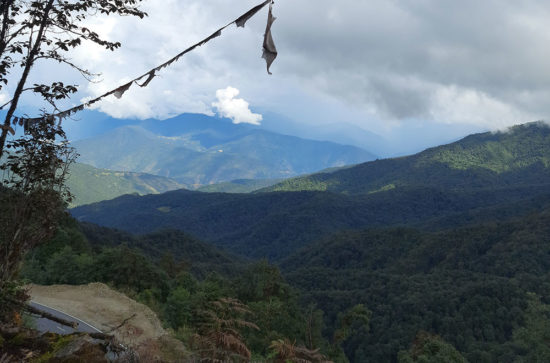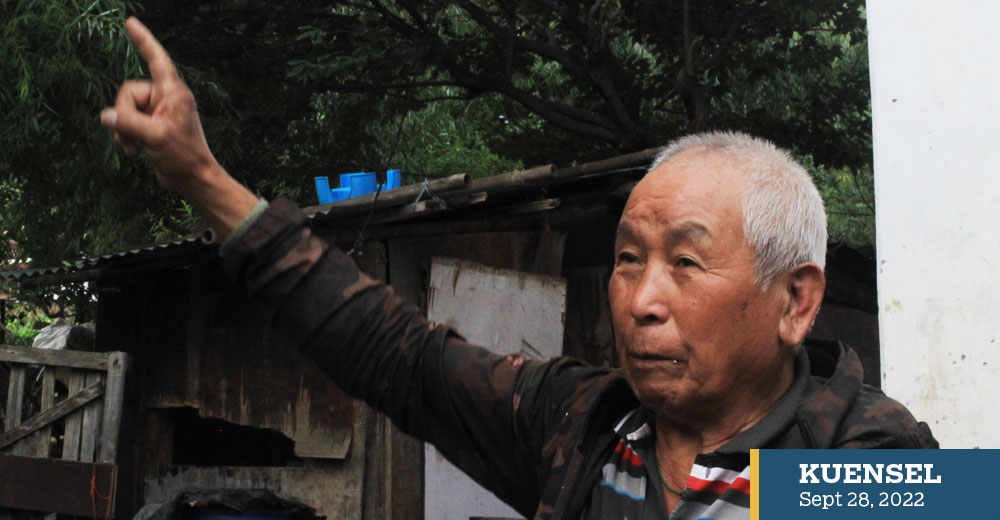… as a part of the Trans Bhutan Trail that will be launched today
Nima Wangdi
Once every chilly autumn morning at Changluetoe village, near Lungtenphu in Thimphu, the two sisters wake up early.
The eldest sister pours the feed for their family pigs into a dark feed-stained wooden bucket and greets the seven grunting pigs outside the house. With the bucket lodged on her shoulders, she draws them towards Semtokha. The other sister chases them from the back. At the junction near Semtokha, the animals eat.
The two sisters return home leaving the pigs on their own. The pigs appear in front of their home by evening. This goes on for three mornings.
Dophu, now 79, witnessed his sisters do this every autumn before the family and others in Changluetoe set off to their winter home in the warm valley of Punakha to escape the freezing winter in Thimphu. It was practice for pigs before embarking on their three-day winter migration trip to Lobesa, their winter home.

A view from Dochula-Lobesa trail
“The pigs practice walking. They walked like cattle along the path to Lobesa,” Dophu said.
Some families took two days while others took three days. It depended on how early they started.
He said it was difficult for the people to go to Lobesa as they had to take along everything: children, elderly people, chickens, cattle, pigs, cats, and sometimes carry sick people on their backs.
Families began preparations for the migration almost a month before the actual journey. Most families owned seven to nine pigs and up to 40 cattle.
Villagers stocked rations like rice, dry meat, locally brewed liquor (ara), vegetable, cheese, butter, and eggs for the journey. Farmers would have already harvested the paddy in Thimphu and sown wheat before they left for Punakha. The cattle would have finished eating fresh nutritious paddy stalk roots in the paddy fields.
They migrated by the mid of 10th month of the Bhutanese calendar and started to return from the first to mid of the second month.
They placed thorny plants carefully on the windows to prevent thieves from breaking into their homes while they were away. The doors were locked.
Most used cattle, besides the horses, to carry the ration, bedding, household items including utensils, and children. Chickens were put in bamboo baskets, and children were strapped to saddles.
They would halt the night near a spring at Dochula. They stopped and began preparing their camp and feed for their animals after sunset.
Why migrate
People living in the Lungtenphu and Babesa areas owned paddy fields in Punakha. Their census was registered in Barp gewog in Punakha until they were clubbed under Thimphu dzongkhag. The sharecroppers in Punakha cultivated their paddy fields while they lived in Thimphu.
This was the reason why people of these areas in Thimphu migrated to Punakha during the winter.
Dophu said those who owned more paddy fields in Punakha returned home with paddy and rice after living three months in Punakha. He said that his family did not own much land in Punakha.
They lived on the paddy they collected from sharecroppers for three months and returned to Thimphu. They could bring very little paddy to Thimphu.
He said, for most of them, there was no other reason to migrate. They were there to consume their share of paddy.
Not many people owned houses in Punakha. Dophu’s family camped in the open paddy fields where they built a shelter out of dried hay.
Dophu said the trail starts from Semtokha and followed the course of Olarongchu.
“We have to cross the stream around eight times before climbing up to Dochula. At some points, there were a few bridges made out of large tree trunks. People had to walk through the stream where there were no bridges.”
“After Dochula, then climb down the other side of the pass,” he said. There were no shelters on the way and they ate nutritious food including meat and dairy products with rice during the trip.
The last time he walked to Lobesa on this ancient highway was some 40 years ago. He could still recall the details of the journey with much clarity having taken the path half of his life.
People stopped taking the trail shortly after the motorable road between Thimphu and Punakha was built. It became easy for them to bring their paddy to Thimphu in vehicles. Villagers of Babesa still own paddy fields in Punakha.
He said, once the people had returned to Thimphu, most never turned back to Lobesa during the summer. Even if they had to, they never spent the night there. This was because people feared malaria if they lived in warm Lobesa in summer.
But many looked forward to the annual journey to Lobesa after toiling in the fields for the most part of the year. They would sit around the campfires drinking, frolicking and singing.


